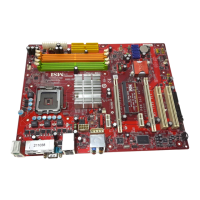
Do you have a question about the MSI MS-7346 and is the answer not in the manual?
| Brand | MSI |
|---|---|
| Model | MS-7346 |
| Category | Motherboard |
| Language | English |
Details the technical specifications of the MS-7346 mainboard, including processor, chipset, memory, and I/O.
Visual guide illustrating the placement of key components and connectors on the mainboard.
Lists the items typically included in the mainboard package for user verification.
Provides instructions for installing the CPU and its associated cooler to prevent overheating.
Guides on installing memory modules and understanding dual-channel memory configuration rules.
Details on connecting the power supply and various internal/external connectors on the mainboard.
Information on configuring jumpers, using board buttons, and understanding expansion slot types.
Explains the function and status indicated by various LEDs on the mainboard.
Instructions on how to enter the BIOS setup utility and navigate using control keys.
Describes the main BIOS menu options and their general functions.
Covers basic system configuration like date, time, and IDE/SATA device settings.
Details advanced system settings, including boot options and security features.
Configuration options for onboard peripherals like USB, LAN, and Audio controllers.
Settings related to ACPI functions, sleep states, and power button behavior.
Advanced settings for CPU, FSB, DRAM frequencies, voltages, and overclocking.
Options to load fail-safe/optimized defaults and set BIOS passwords.
Step-by-step guide for installing the Realtek HD Audio driver for proper functionality.
Instructions on accessing and configuring the HD Audio Manager for audio features.
Options for selecting sound effects, simulating environments, and adjusting equalizer settings.
Adjusting volume levels, managing playback devices, and enabling multi-streaming.
Settings for microphone input, muting, and enabling multi-stream recording.
Configuring audio output modes (2/4/6/8 channel) and connecting speakers.
Overview of RAID technology, system requirements, and basic array configurations.
Steps for configuring NVRAID arrays through the system's BIOS utility.
Instructions for installing the necessary RAID drivers for bootable and non-bootable arrays.
Using the NVRAIDMAN application for viewing and managing RAID array configurations.
Procedures for setting up spare disks, morphing arrays, hot plugging, initializing, rebuilding, and synchronizing.
Details on system requirements and how to activate the Dual Core Center utility.
Introduction to the main utility functions for monitoring CPU, GPU, and system parameters.
Adjusting and monitoring system clock speeds and voltages for performance tuning.
Reading and adjusting fan speeds, and monitoring system temperatures.
Creating and managing custom profiles for clock, voltage, and fan speed settings.